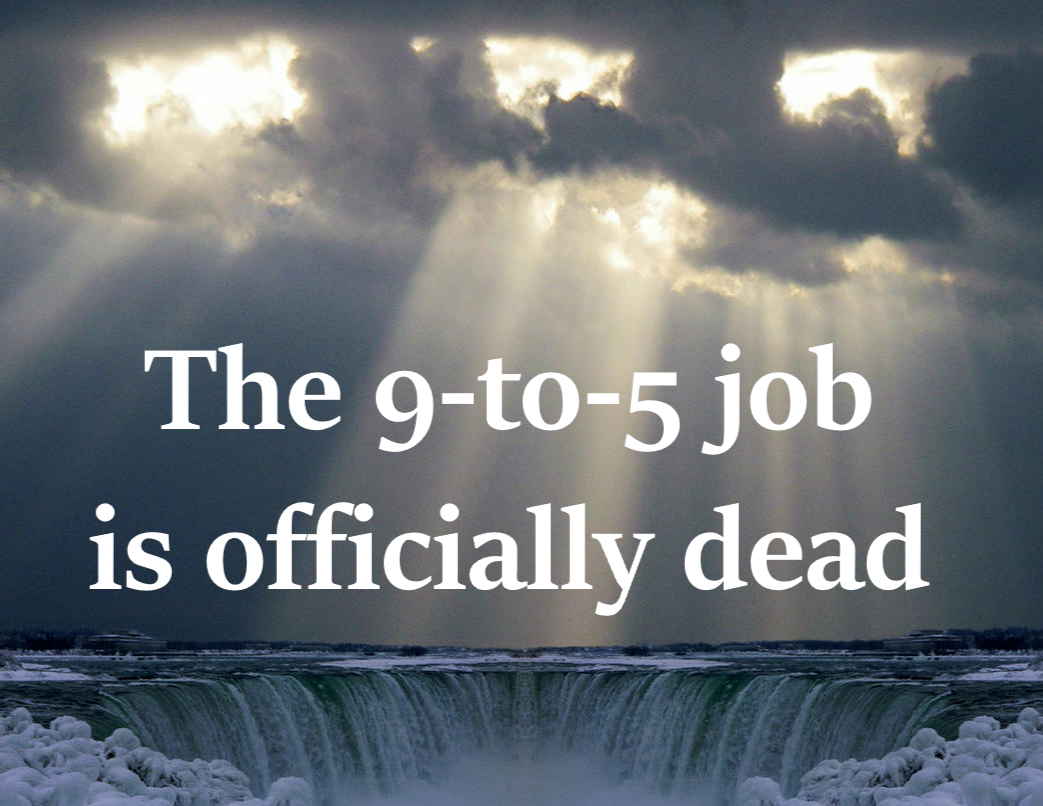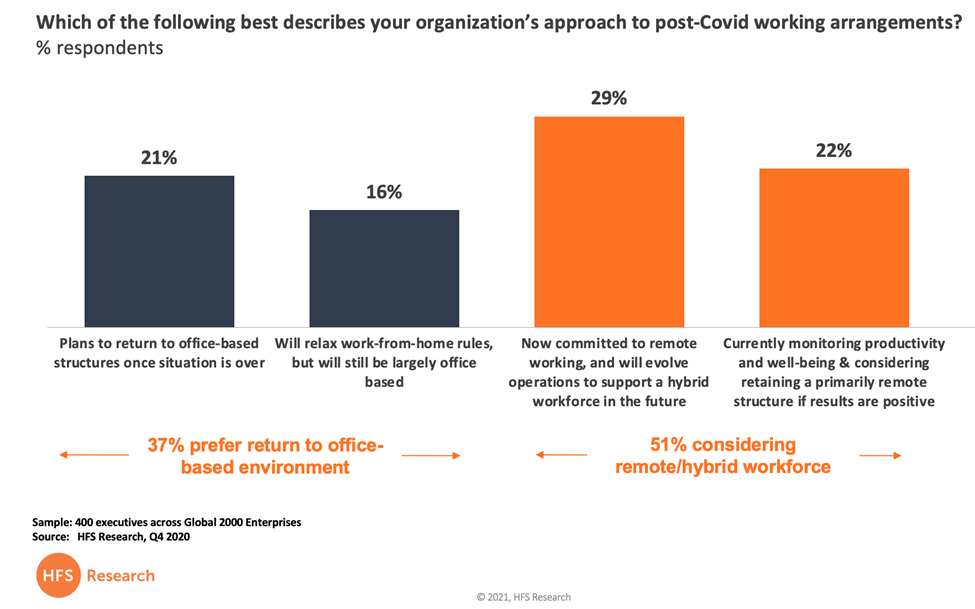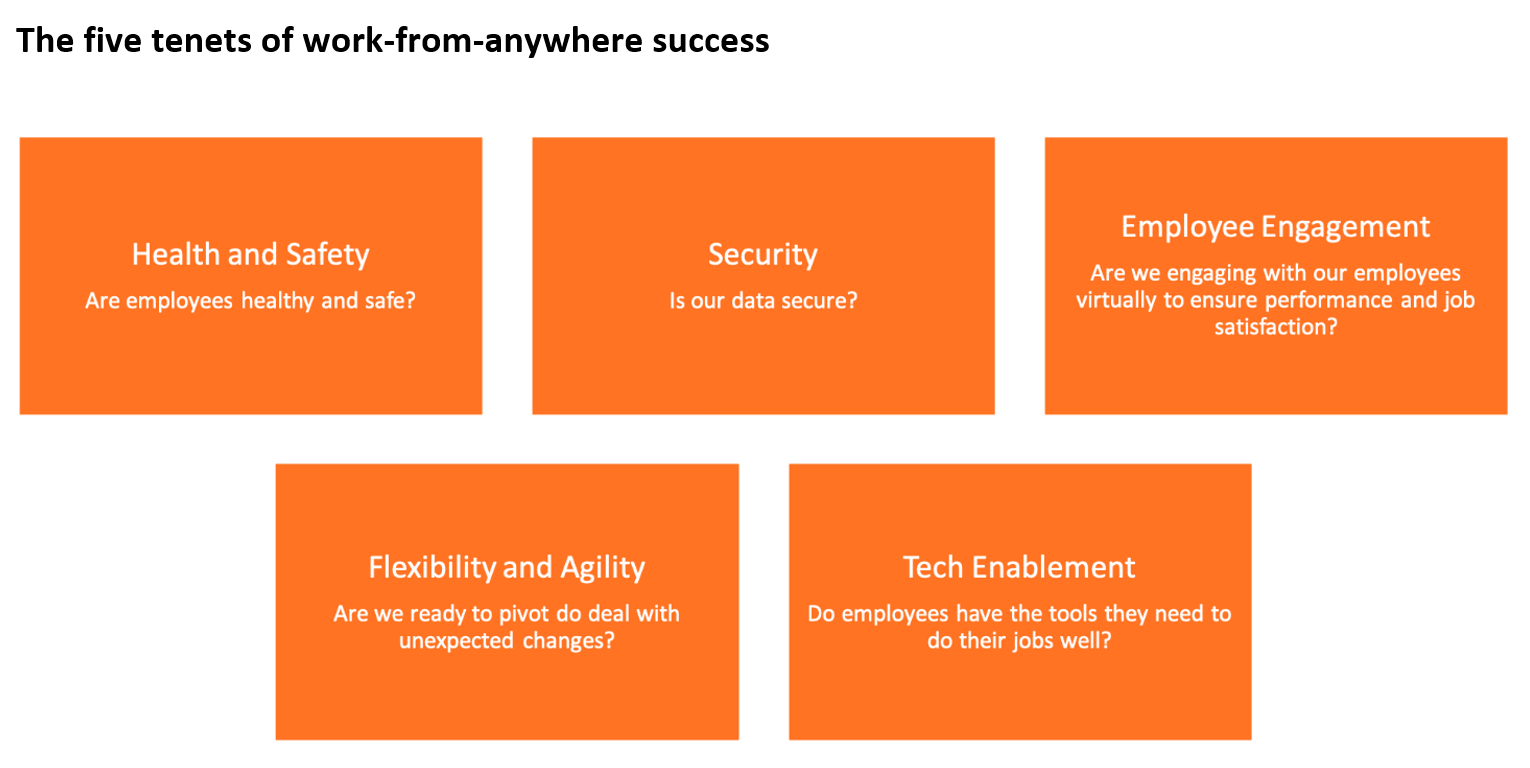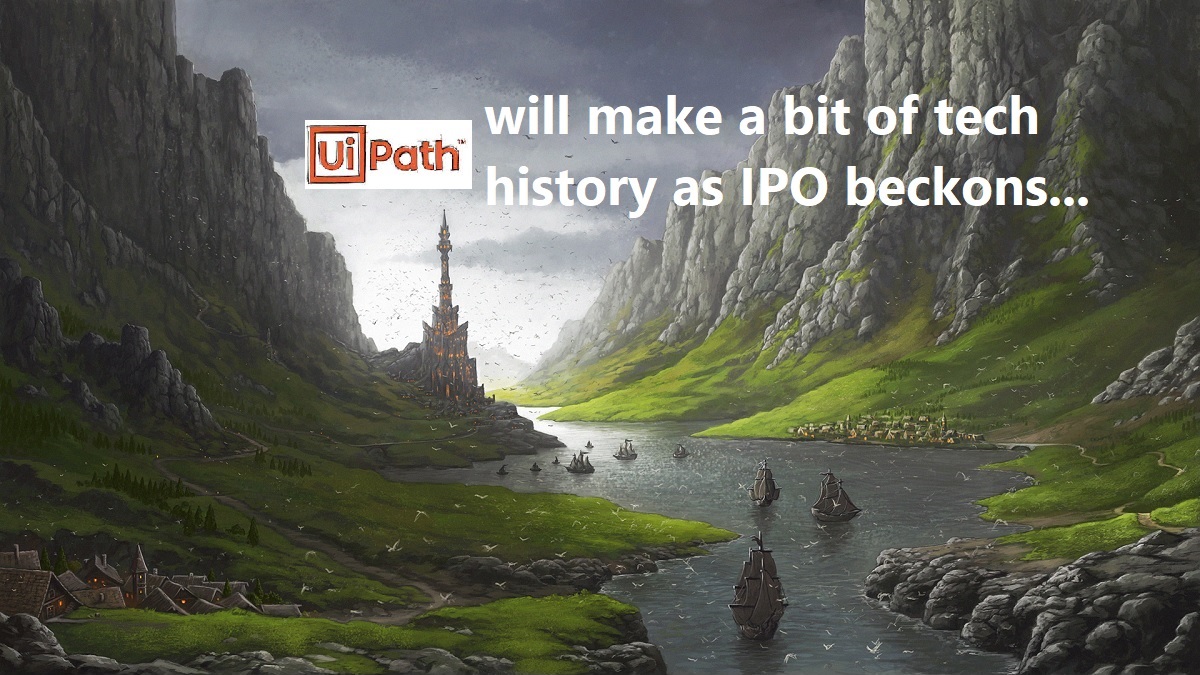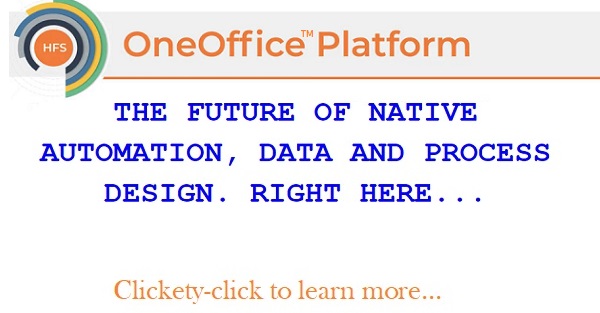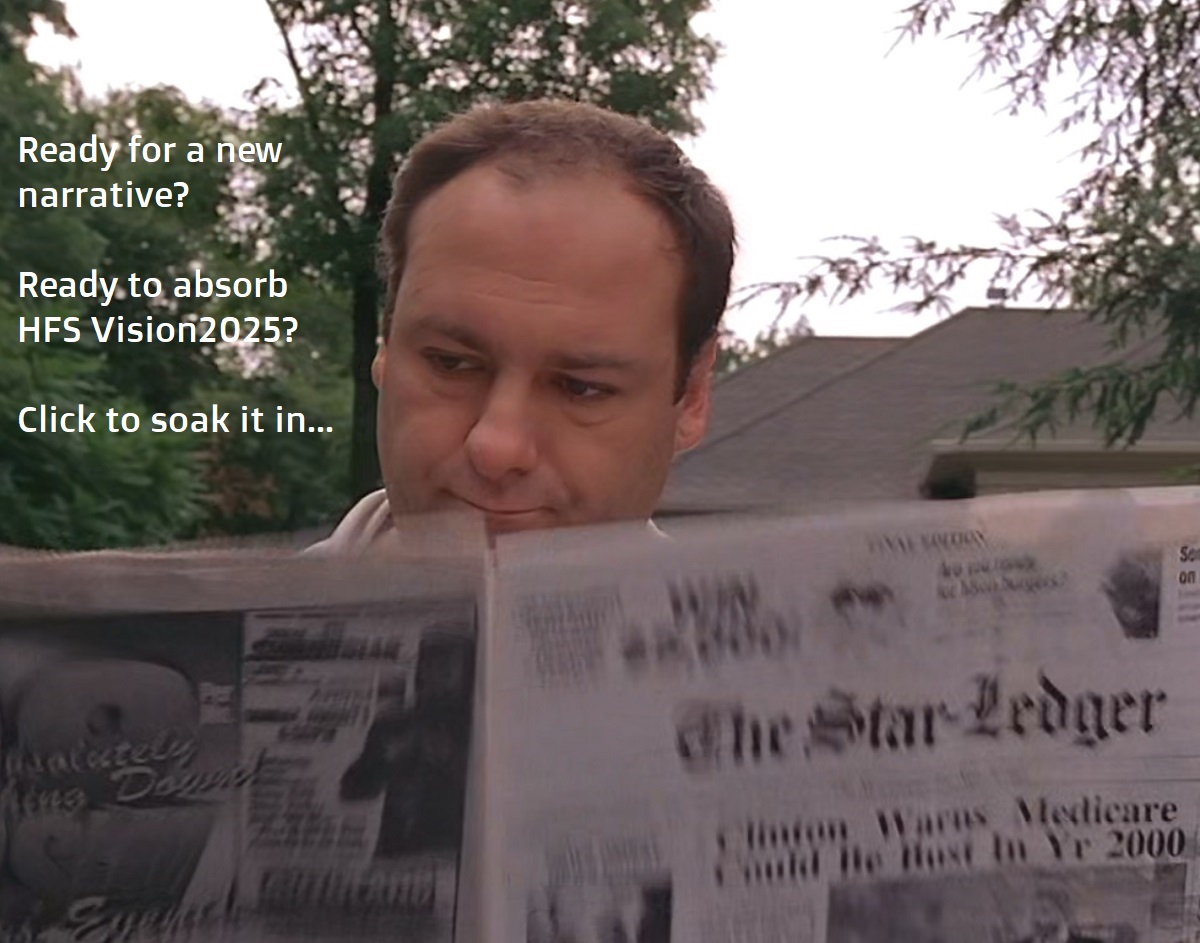
It’s time to make Sanjay Jalona a services household name in the IT services industry. He made the jump from leadership positions at Infy to CEO and Managing Director of LTI in 2015. When I pulled up their stock chart I had to rub my eyes – thought for a moment that I was looking at the acceleration of COVID across the globe. But no, that’s the 5-year snap of LTI’s stock growth. Sanjay has lead LTI through an IPO in 2016 to continued momentum in growth across capabilities today.
The COVID landscape has created massive pivots across the industry, so I was deeply curious where he was taking risks and deep dives for the future – as he will say, the capabilities where he’s “throwing the kitchen sink.” And speaking of the kitchen sink, we touch on everything from leading and learning with Shoshin (a beginner’s mind) to the positive changes sweeping India. Let’s begin:
Phil Fersht, CEO and Chief Analyst, HFS Research: It’s great to see you again, Sanjay, and have you join us for an HFS conversation. This is the first time we’ve had a “live” discussion, so it’d be great to have you introduce yourself a bit to our network – a little bit about Sanjay Jalona, how you ended up running a business like LTI, and a bit about how you started out. Did you always want to do this, and was this what you dreamed of? And then we’ll talk a bit more about the industry and where things are going there.
Sanjay Jalona, CEO and Managing Director of Larsen & Toubro Infotech (LTI): It’s always a pleasure to talk to you, Phil. I grew up in a small town, up north in India – six hours’ drive from Delhi in the foothills of the Himalayas. My father worked for a pharma company all his life. I studied there in a Hindi Medium school, and then went to study computer science at BITS Pilani. After that, for the last three decades, I have been involved in nothing else but the technology business.
So, I guess I’d reckon that I would completely be useless outside this industry [laughs]
I have done a lot of coding in my life; I have run delivery functions; I have run large, critical programs for our customers, so I have traversed both sides. I have been here at LTI for over five years now – time flies when you’re having fun, right? – but for the 15 years before that, I was at Infosys.
“I have been very lucky, for the last three decades, to work with great, great leaders and mentors.”
I have been very lucky, for the last three decades, to work with great, great leaders and mentors. I started my career at Wipro, and I got a chance to work with some of the brightest leaders there. Then I worked with a lot of leaders at Infosys: Kris, Shibu, Nandan, Mohandas Pai, BG Srinivas, Ashok Vemuri, and the likes, a very close association, and I learnt a lot from them. It was a great, great experience.
“The world was changing dramatically; the digital technologies, or exponential technologies, as I call them were coming into the fray, and there was a need for a new kind of a tech company, a solutions company. And I saw that as an opportunity…”
I thought I would retire from Infosys, frankly, but, lo and behold, there comes a time in everyone’s life when you say, “What next?” The world was changing dramatically, the digital technologies, or exponential technologies, as I call them, were coming into the fray, and there was a need for a new kind of tech company, a solutions company. And I saw that as an opportunity and met with Mr. A. M. Naik. I went with the simple mindset to go and meet an industry stalwart; I had no interest in leaving Infosys at that time, but you just cannot meet him and not be influenced!
I have worked with some great people who have built India in a definitive way, and I have enjoyed every single day of my work and life here. I thought CEO would be a lot easier, but we have seen so much happening in the last five years; the onslaught of exponential technologies, Brexit, COVID, all kinds of problems all around the world, the protectionist environment. There’s not been a single dull day, ever.
So that’s who I am. I’m grateful to be surrounded by great people. If there’s one thing that I have learned, very early in my life, it was that leaders have to have at least three – if not four – people who could potentially replace them at any given point in time. And I’m so blessed to actually have what industry experts have called a dream team, and we have stuck together. I’m lucky to be working with them to bring the company to where it is now.
So that’s who I am in a nutshell.
Phil: Fantastic. So, you’ve come through some of the biggest names in the industry, you know, I recognize a lot of the people you’ve spoken about, like Shibu, and, in particular, Nandan. What did you learn from these guys that you took into LTI and maybe tweaked a little bit? What did you take from the ingredients from these earlier champions in this industry that you felt you could infuse into the firm you’re in now?
Sanjay: Many things, Phil. Some 25 years back, I was at Wipro and overseas somewhere. I think I was in the US, and Premji had come visiting. And I was really a newbie with three or four years of experience and was finding it challenging to schedule executive meetings for him. He turns around and says, “I’m happy to meet the Project Manager. He is the one who’s putting the bread on the plate.” So that kind of humility is the first thing that you learn when you get into the professional world.
“Humility is the first thing that you learn when you get into the professional world. …And frankly, you learn a lot from very difficult bosses…. Dealing with being flexible, learning in the most difficult situations, and working with customers to find solutions are some of the things that I learned from these mentors.”
High aspirations, building teams, and working with limited resources, to get the best out of people is what I learned at Infosys. And frankly, you learn a lot from very difficult bosses, as well. Right? So, dealing with being flexible, learning in the most difficult situations, and working with customers to find solutions are some of the things that I learned from these mentors.
Phil: Interesting. And then let’s get to 2020. I think many of us feel that we learned more in 2020 than ever about ourselves and our qualities, and maybe where we need to improve, as well. Do you feel last year has been the biggest learning year for you as a leader?
Sanjay: Oh, in many ways. I think we are frankly rediscovering, or have rediscovered, some dimensions of us that we never knew existed. If you were to ask me if I felt the same way in February/March last year, when COVID actually hit the first time, I would have never imagined that we would be here. There was a sense of panic. I was truly scared at that time about how we would keep our promises? How would we keep our employees safe? How would we grow? If you are a publicly listed company, you are expected to grow. And none of us had ever experienced anything of this sort in our lives before. We had never seen this before.
I think there was great character shown by “LTItes” going that extra mile. We had cases of people picking up their computers in the middle of the night, a seven-months-pregnant lady coming at midnight; there are people ferrying computers all over the place; there are customer calls, people following simple basic principles, like call five new people at 5pm, every day, for five days. This exemplifies the social fabric that binds us all together that has come to bear.
“We never thought we could connect with as many people as we are able to do today. There are days where I connect with four, five customers from all across the geographies. From a single click, I am connected more to people inside our organisation, our 30,000-people organisation, than I ever was in the last five years. So, there are lots of positives.”
We never thought we could connect with as many people as we are able to do today. There are days where I connect with four, five customers from all across the geographies. From a single click, I am connected more to people inside our organisation, our 30,000-people organisation, than I ever was in the last five years. So, there are lots of positives.
But there are things which you start to miss, as well. That social fabric that has bound us together. The individual productivity might be high, but we need ideas flowing in a setting where people are working together, they are fighting, they are arguing, and they bring their best to bear.
“But we need ideas flowing in a setting where people are working together, they are fighting, they are arguing, and they bring their best to bear… I think that energy is what we start to miss.
I think we have discovered that there are great characters all across, be it customers, be it employees, who have all come together to solve a problem and take care of one another, and I think that’s the big positive.”
I think that energy is what we start to miss, but I think we have discovered that there is great character all across, be it customers or employees, all came together to solve a problem and take care of one another, and I think that’s the big positive.
Phil: Interesting. We can talk about some of the challenges, but, I mean, we were predicting 8 to 10% decreases in the services industry back in March, and I actually think it’s been flat to a small growth increment this year, believe it or not. Despite everything, we’ve actually still grown the industry, and I feel very blessed to be in this space.
Are we lucky to be in this space? Do you think this will continue to be a blessed area, where companies will always depend on us? Or do you think this is commoditising and we need to wise up, and be prepared for tough times as well?
Sanjay: I think we are coming to the next phase of the growth curve, Phil, if I were to call it that, and this is definitely a dichotomous world today. On one side, you have a COVID-related impact; there are macro and microeconomic issues. But on the other hand, every industry and every company needs to operate in a new operating model. Insurance companies need to do remote insurance for people, and distribution of insurance, and digital claims. A bank needs to be able to digitally onboard a customer, you or me, without ever seeing us. A retailer has to have the ability to order online and pick up on the curbside.
“I think we are coming to the next phase of the growth curve, Phil…. But today, it’s about survival for everyone, so I think it’s opened a plethora of opportunities for IT companies to operate in.”
There are things which are required to be done for every single company. But today, it’s about survival for everyone, so I think it’s opened a plethora of opportunities for IT companies to operate in.
You are seeing industries that were typically B2B becoming B2C. You are looking at new operating models; you are seeing people looking at cutting costs so they can fund all of these. Cybersecurity gains even more prominence because people are totally distributed. This is going to lead to tremendous opportunities in fewer areas, cloud, and data, for example – two predominant things that come to mind in a very big way.
“Speed of execution is very important, but the most important thing is the ability to co-create with the customer. And if you don’t have the depth and the knowledge of that vertical, I think you will struggle…”
Speed of execution is very important, but the most important thing is the ability to co-create with the customer. And if you don’t have the depth and the knowledge of that vertical, I think you will struggle to have a discussion on what the target operating model for the customer would look like. And there are many verticals which we don’t operate in. This is not a good time to start in a new vertical because what would you go and tell them? But the depth in the verticals that we do operate in, I think there is room for doing more in our totally trusted advisory kind of a capability, co-creating the solutions.
It’s a great opportunity, but it’s very difficult to do this. It’s easier to do it in our asset base, our customers. It’s even more difficult to go outside that asset base and do that. And that is the tricky situation.
Phil: But is that because we’re only just getting used to the fact that we can actually build relationships with people on a video screen? I know it’s not ideal, but we’re going to have to get used to it for a while, and it’s easy with people you have relationships with, which takes me on to something else, which I think is very pertinent.
The one thing I see in spades from a lot of customer conversations recently is that decisions are getting made much faster, and they’re actually being made, and customers are executing now. Between 2010 and 2020, when cloud appeared and digital evolved, and AI, and everything… we spent a lot of time figuring out what is possible, but we didn’t really execute on it. It was a lot of time just figuring it out.
Suddenly, it’s, “Okay, all that great stuff we talked about, a lot of this now has to happen, and very, very quickly,” with the conversations on the client-side leading to a rapid, rapid desire to execute. I think there’s a focus on, “We need partners who can get us there. They don’t necessarily have to be the best or to have the greatest technology, but they need to be able to get us there. And they need to have the ability to do it fast and understand us as they do it because we need to operate in a cloud environment. We have to automate processes, so they function in a cloud environment; we have to figure out what those are, and then we have to then look at things like AI so that we can orchestrate those processes effectively.”
“Everything is sort of in a cloud model now; it’s much more standardised. …If you’re on the IT side of things, you’re spending more time trying to figure out how to apply this to what your business customers need than to figure out how to actually just make it work.”
Your business customers are trying to figure out, “What is it we do need? How fast can it scale? We don’t have to know how the technology works, per se, but we need to know how it enables these processes to run.” So, we’ve got this rapid change, from great ideas to speed, to get-it-done-fast-and-don’t-mess-it-up.”
Sanjay: Yeah, speed is very critical now. Very critical. And Phil, you’ve got to remember that companies that had adopted the cloud were able to go to remote working a lot less pain than people who had not adopted the cloud. Today, if you look at the kind of roadmap and the speed at which even regulated industries like banking, insurances, life sciences, etc., are moving in the adoption of the cloud, it is next to none.
“We have created a separate unit focused on AWS, a separate unit for Azure, and GCP, and we have taken all our investments… We want to divert the bulk of the investments for the company to all things cloud. The second area where we are investing bigtime is all on data products.”
This is where, Phil, we have created a separate unit focused on AWS, a separate unit for Azure, and GCP, and we have taken all our investments… We want to divert the bulk of the investments for the company to all things cloud. The second area where we are investing bigtime is all on data products. We have great IP in what we build, Mosaic, and Leni, which is an augmented analytics piece – really, really cool, you should look at analysing that.
“We believe there are great opportunities in the marketplace, so we have created these two new growth engines. Looking at COVID, we had to expedite this in a big way, so we are throwing the kitchen sink at these two ideas for the future.”
We believe there are great opportunities in the marketplace, so we have created these two new growth engines. Looking at COVID, we had to expedite this in a big way, so we are throwing the kitchen sink at these two ideas for the future.
Phil: And in terms of who clients are picking as partners now, it feels very different. “Brand” is kind of out of the window a bit now; it’s who understands us, who knows us, who can get us there. How are you making sure that LTI is on that final three trusted list with your key clients? Do you feel that you’re there at this point, that you’re in the place you want to be? Or do you think this is still a lot of jostling for position where everyone’s kind of looking at each other trying to figure out what to do?
“We want to be positioned very simply as small enough to care, but large enough to deliver… We strongly believe we have the depth in capabilities.”
Sanjay: We want to be positioned very simply as small enough to care but large enough to deliver. So as the deal sizes have shrunk, we strongly believe we have the depth in capabilities, and that’s the part on which we have seriously focused over the last five years. You would not find anybody who has probably built as many alliance partnerships, as many capabilities internally, or acquired six companies all on capability – none of them more than $15-20 million – but really creating a niche for ourselves. We were the first ones to build up with Snowflake, for example. We have the lead partnership there.
“If you have the capabilities, people will come to you. And, frankly, we like the positioning of the number one challenger. For us, growth is a lagging indicator; capability is the leading indicator.”
If you focus, if you build the roads, people will come on the roads. If you have the capabilities, people will come to you. And, frankly, we like the positioning of the number one challenger. For us, growth is a lagging indicator; capability is the leading indicator. Do we have the right capabilities?
Five years back, if you reflect, we had zero capabilities on core banking. Today, we are the second-largest partner in the world for Temenos, for example. Second largest partner globally. And this would not have been possible if we did not methodically go on filling up these white spaces, so to speak. And that’s what we believe we do well.
“Customers used to source for scale. But now, companies source for excellence, source for capabilities. And that is the difference.”
Customers used to source for scale. “Which company has the ability to serve me globally? Can give 5,000 people at any given point of time?” But now, companies source for excellence, source for capabilities. And that is the difference. This is a phenomenon that has changed in the last five years.
Phil: Yes. It’s been a rapid, rapid shift. And I think we will continue to have a tough winter during the next few months, I think people are getting savvier on the length of time it’s going to take for a big global population to be vaccinated, but at least we know it is going to happen, right?
Sanjay: Yes, exactly.
Phil: And 95% success probability. So, this means this situation will drag way into the latter parts of 2021. I’m hoping we open up a little bit, at least, because there was a period this year when we had some ability to move around a bit, but there’s a long time ahead for us here. This is a situation now where we have to look after ourselves and look after our jobs, and our friends, and everything. So, what should we do next? Because I sense a lot of people are getting fairly tired; they’re struggling. I spend most of my day trying to motivate people.
My 11-year-old son tries to motivate me. [Laughs]. But this has got a long period to run still. The good news is there is an end, but there’s still a long period to run, and I think we’ve held up amazingly well. Can we keep doing this? Or do you think there’s going to be some rough patches in the next few months?
Sanjay: You know, I hope this thing gets over a lot more quickly than probably what you’re pointing out, and we are at least able to meet people. We need a social fabric. There are kids who are starting colleges and who are starting their professional lives at this time. A lot of us have survived because of the connections that we had built earlier.
Lots of them have to build them still, to do well, and to understand who they are. So, life after COVID, I hope it starts very rapidly. But, frankly, there are a few things that I am concerned about. One is health. So, within our boundaries at LTI, I write a lot about people needing to find ways and means to exercise and eat healthily.
Mental health is a very big issue in these times. How do you connect with more and more people? We are starting some initiatives on mental health and the ability for people to call one another, having a central desk for people to call up, and so on and so forth.
“I am a big proponent of something called Shoshin, which is a beginner’s mind, and this is a great time for people to invest in themselves. How do you learn? How do you use this time to learn new capabilities?
It’s very easy to go to that next email rather than investing some time in yourself. So, I’m talking a lot about people creating “me time”…to learn new things at this time and to just connect and be there for one another.”
I am a big proponent of something called Shoshin, which is a beginner’s mind, and this is a great time for people to invest in themselves. How do you learn? How do you use this time to learn new capabilities? Because it’s very easy to go to that next email rather than investing some time in yourself.
So, I’m talking a lot about people creating “me time” and applying the basic principles of Shoshin, a beginner’s mind, to learn new things at this time and to just connect and be there for one another. It’s very important for all of us to do that. Frankly, I think productivity is very high because people are paranoid, but I think people need to have more than just work and focus on some of the things that I have just said.
Phil: Yes. Well said. I very much agree with some of this. And I’m not as pessimistic about next year as other people are. I think April, May, maybe June time is about the time I’m hoping to at least do a little bit of travel, a little bit more face to face. Just getting out and seeing people once or twice a week has been huge for us, by the way…
Sanjay: Well, I’ll tell you my thinking, Phil, on this. My wife decided over the weekend that she was going to book our vacation for next year. This is the summer before my daughter goes to university, and we are optimistic. We need to be optimistic! We have made a booking and will see what happens. Hopefully, we’ll still get to travel in the summer.
Phil: Certainly. So, we’ve spoken about COVID, and the industry, and things like that. Let’s look beyond that. We talk a lot about the new dawn, and the fog lifting – new ideas, new paradigms, energy, recessions end, and things replace them. What do you think, honestly, when this thing lifts, and we’re back in a world where we can do everything we want again? What do you think are going to be the differences from what life was like before?
Sanjay: Look, I don’t think we would ever go to 100% people working from the same offices, but I do not think it’ll be 70% or 80% working from home, either. There will be a hybrid model. It will allow you to get to the best talent which might not be able to come to locations, but I think it is important for us to have the exchange of ideas and flows there. We are not in an individual sport; we are a team sport. And it’s very important for people to ideate together to make this happen. So that is the first change that’ll happen.
It will create a gig economy. It’ll create the ability for people to tap out, you know, “Phil is an expert in some technology, which is good, but he lives in a nice, fancy place which he doesn’t want to leave and come to some part of the world where it’s required. But it’s okay, Phil can be tapped into this model, and it’ll be perfectly fine.”
“I think there is a big change coming for India, and I think it’s a positive change. …We have not created very many women leaders.
…They don’t need to have gaps anymore. They can continue to work even when they are pregnant or when they are working from home. We need to create an umbrella and an opportunity for them to do that. This should create a lot more leadership from women, and I think the world will be a lot better place…
As the COVID response itself has shown us, that wherever you have women at the top, the response has been far stronger and far better.”
I think there is a big change coming for India, and I think it’s a positive change – and I’ve talked very passionately about this. I think one failure if I have to associate one with my work for the last 30 years, we have not created very many women leaders. And I think this gives an opportunity for women, who have a bigger role in India, because of lack of social security, and frameworks in there, where they play roles of not only professionals, but wives, and mothers, and daughters, and daughters-in-law, and a lot more responsibility falls on their shoulders.
They don’t need to have gaps anymore. They can continue to work even when they are pregnant or when they are working from home. We need to create an umbrella and an opportunity for them to do that. This should create a lot more leadership from women, and I think the world will be a lot better place… as the COVID response itself has shown us, that wherever you have women at the top, the response has been far stronger and far better. So, I think that will be a positive.
I think things that will not change Phil; if you have a story to tell a customer, the value definition might change, but value creation will not. Customers will always find the money for you to work on that. That will never change.
“I think being passionate about clients’ success is never going to change. …We are in a people industry; valuing our own people is never going to change. I hope one thing will change is that we start to think in a much more unconstrained way.”
I think being passionate about clients’ success is never going to change. It might morph itself into something different. We are in a people industry; valuing our own people is never going to change. I hope one thing will change, is that we start to think in a much more unconstrained way. You know, humans, and more so probably the IT industry, think in a much more constrained way than we should, and hopefully, all of us have had some downtime to think about things that can dramatically change for all of us.
Phil: That’s wonderful. Well, I think we’ve conducted a lot of conversation, and I really look forward to sharing this with everybody. I think it’s been fantastic to hear your views, where you came from, where you want to go, the challenges, the opportunities, and Shoshin, and some of your values as well. I’ve really enjoyed hearing from you, and I’d love to catch up again with you soon because we have some great stuff coming out of our company. And maybe, when it’s nice and sunny again, I’ll be back, hopefully, stateside, and we can have a chat in person.
Sanjay: I look forward to doing that, Phil. I’ve really enjoyed our conversation, and we hope to build an even greater partnership.
Posted in : Cloud Computing, Digital Transformation, IT Outsourcing / IT Services
Why we think SAP acquiring Signavio is a non-event and actually frees Celonis from its SAP shackles to inspire its loyal following
The initial buzz from SAP leaders with its Signavio acquisition all points to helping its clients migrate from legacy systems onto cloud-based S4/HANA applications. While that is a worthy goal, SAP needs to embrace how to support both non-IT and IT clients with rapid process redesign, if it is to stand any chance of reclaiming former glories that are long-distant memories in today’s high-octane environment. The German software giant has an IT-centric view of the world, where instead we need technology and business to come together to become fluent in understanding the data they need to be effective in their markets. To create this data, processes need to be designed to deliver data at speed, and these need to be automated in the cloud to keep their enterprises functioning. Once processes are flowing beautifully in the cloud, you can deploy all sorts of ML and AI tools to gather increasing amounts of intelligence to anticipate your own needs – and your customers – ahead of time.
Until a decade ago, SAP was, perhaps, the most significant brand and voice in enterprise technology. The German software supremo was the enterprise backbone, the system of record, the “way of doing things” for the majority of the FORTUNE 1000. Back then, Microsoft was already entering rigormortis as a decrepit office suite, SFDC wasn’t much more than a fancy way of managing your contacts, while Workday was confusing everyone with “thin memory”, and Oracle was just a weird collection of tired con-fused software firms run by a guy who resembled a tech billionaire version of Donald Trump.
Since then, the SaaSy likes of Salesforce, Workday, and Coupa have long-driven a narrative that you had to run your processes in the cloud, while SAP labored to catch-up as a “Cloud player”. Then came the digital juggernauts of Microsoft, Amazon, and Google to ratchet the world of enterprise technology into a very different place, where data is king and it doesn’t matter how unstructured it is.
SAP has long-lost its enterprise appeal as the process connoisseur’s tech suite of choice
SAP is a symbol of a long-forgotten time when people’s careers were tied to it, when enterprises thought being locked-into an on-premise software suite was considered a strategically smart thing to do. Hell, any IT bigwig worth their salt needed SAP plastered all over their resume. But those days faded away after 2010 as the cloud took over the core processes in smart enterprises.
SAP made its long-rumored acquisition of workflow and process intelligence vendor Signavio official last week. The move has implications not only for the two merging tech companies, but also the market leader in process intelligence, Celonis, that until now, enjoyed a close and successful partnership with SAP. In addition, Celonis has cultivated many strong partnerships with the likes of Accenture, Cognizant, Genpact and IBM. Will they gravitate towards as SAP-owned Signavio? And will SAP’s army of customers really take this seriously enough to fight their CFOs for yet more cash to pump-prime the Waldorf machine? The depressing answer for both SAP and Singavio is simply: no one really cares.
Why SAP needs all the help it can get to earn credibility as a process orchestration and intelligence player
Every enterprise leader has taken a hard look at their business processes over the last year, seeking ways to streamline and automate tasks and get data on what is working and what broke in the move to remote working. What started as an exercise in somehow keeping the lights on in the pandemic economy, has started to turn into wider initiatives that will have a long-lasting impact. Many enterprises in our research have expressed that ‘there is no going back’, and post-pandemic, they will need a far smarter operating model, technology stack, and data-driven business processes. At the heart of this stack, for most companies, is a hodgepodge of various versions of aging business systems, fragmented over regions and markets, that are responsible for the majority of transactions that keep the business running.
Business leaders seeking their own glory on “digital transformation” and process efficiencies have implemented a plethora of bolt-on tools around core applications over the years, including business process modeling, workflow management, document and content management engines, and of course, robotic process automation. Process intelligence tools have been the latest addition to this mix. In particular, process mining technologies that use transactional system-log data (such as from SAP) to power their analytics and machine learning models.
Why Celonis was so good for SAP customers – and will still be for some time to come
The two principal uses of process mining tools that significantly help enterprises with their SAP estates include:
1) Helping operations leaders make the most of their current ERP and other source systems, find process bottlenecks and inefficiencies, and redesign processes such as order-to-cash and procurement
2) Helping IT teams with systems migration, such as a move to S4/HANA, where the mining technology can be used to map and monitor as-is and to-be processes, and user adoption over time.
Just with those two points, we can see why SAP’s partnerships in this space have gotten deeper in the last few years and got to a point where SAP felt the need to directly invest in a solution of its own. Hence its acquisition of Signavio.
SAP needed to partner with the likes of process intelligence leader Celonis and UiPath (which acquired ProcessGold) to keep its technology ticking, and provide its customers more process visibility and automation. Now it has the ability to define how a fully integrated BPM, workflow, process mining, and automation capability can augment its core technology, beyond what third-party platforms and a host of SAP-specific products have been able to achieve.
Weaning any client with years of experience off of their beloved Celonis to switch to an inferior product owned by SAP is not going to happen… so good luck with that folks!
When it comes to process augmentation, SAP is lightyears behind the market. In 2018, It made a low-budget attempt to enter the Robotic Process Automation (RPA) market with Contextor, a small little-known France-based RPA product to augment SAP Leonardo’s intelligent technologies portfolio. Nothing has been heard of them since, with no examples of SAP playing in the process automation space. It’s been a bust. So if SAP can’t make head nor tail of the most base form of process automation (RPA), why does it think it can take the market by storm acquiring a product which is ranked 13th in process intelligence software:
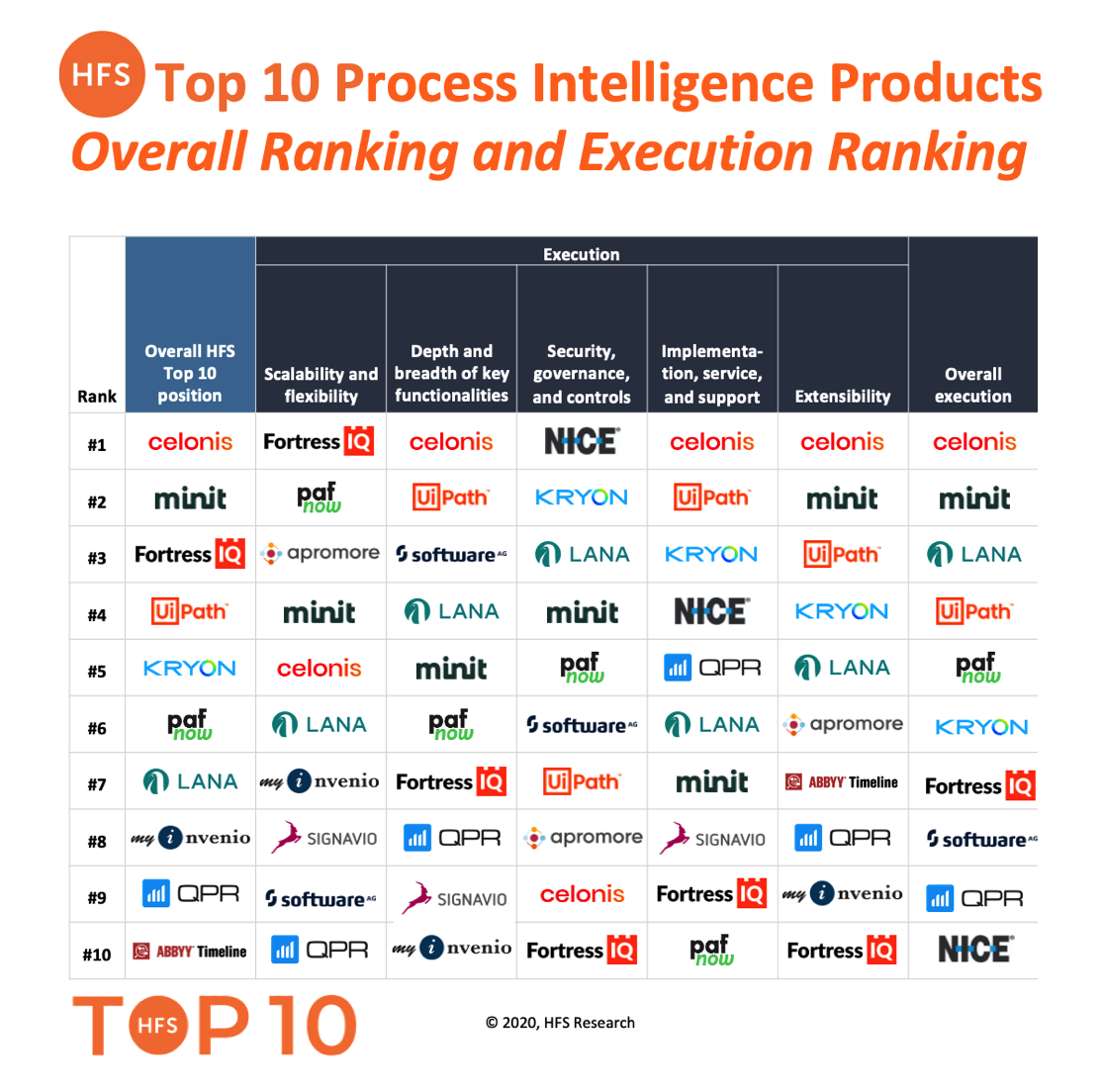
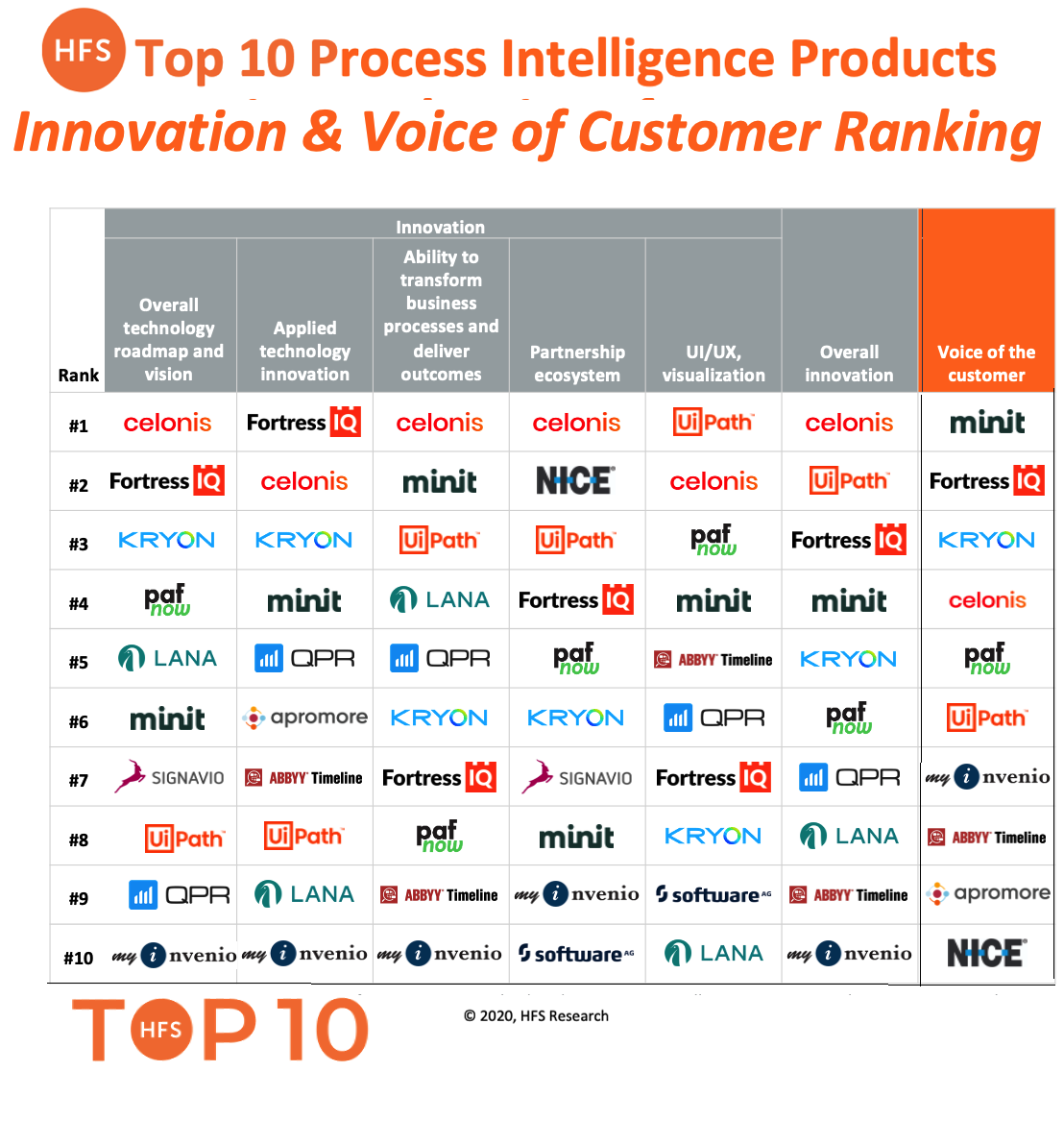
Simply-put, all the hard years the Celonis founders spent driving around Germany selling the software to SAP customers in a VW Camper (yes, I actually know this!), ensured that Celonis has firmly established itself as the process mining solution of choice, necessitating several years of investment, training and change management from its loyal clients. So why on earth would these process-obsessed customers flock to use the industry’s thirteenth best solution?
Why Signavio? Its collaboration hub and process simulation capabilities couldn’t be more timely for operating in the pandemic economy
As our recent evaluation, the HFS Process Intelligence Products Top 10, showed, Signavio has multiple bright spots and differentiation making it a formidable vendor in the rapidly growing process intelligence market. Its collaborative hub is a great place for business users to share results of their process analysis, comment and present, and collectively iterate on improving business processes – invaluable at a time when most organizations are still working remotely, and need more avenues for collaboration. Furthermore, Signavio’s process mining technology, in particular its simulation engine, is considered top of the line by its customers and partners. As we’re still operating in volatile markets, being able to model out changes in business processes and simulate their execution to find potential blockages can prove valuable by de-risking or accelerating needed changes. Lastly, Signavio’s bolster’s SAP with its BPM and workflow technologies, which customers value, especially its ability to port and overlay structured process models into the process mining module for comparison.
Despite the positives, Signavio customers we have spoken to indicate that it needs to invest to keep up with innovations in process intelligence. Many disruptive startups are continually keeping up the pressure – introducing new ML and data handling techniques, and standards in data visualization and UI/UX. Additionally, process intelligence isn’t the full focus for Signavio, which until a few years ago was only a BPM/workflow vendor. SAP may have inherited some challenges in investing in the process intelligence piece of the suite.
Where does the new alliance leave old beau Celonis? In our view, stronger, and on to bigger and better things
It would seem (on the surface) that Celonis has been thrown in a lurch by SAP’s acquisition of one of its competitors. However, there is a longer story of product and company evolution unfolding here, and SAP’s move only further cements the shift:
- Life outside of SAP (Bigger): While SAP was the most common source system for its customers’ transactional data, it was never the sole one. Celonis has been steadily building on its partnerships, as well as technology extensibility into Oracle, Salesforce, and ServiceNow. We expect it to show these partners more love in coming days, which will ultimately only help it serve its customers better. This will allow Celonis to break free from I being perceived as an SAP-only process mining tool and diversifying its range here is a win-win for all stakeholders.
- Moving onto EMS (Better): Celonis has already started expanding out from process intelligence into a Triple-A Trifecta solution approach by blending analytics, automation, and AI with the launch of its EMS last fall. As we observed, with EMS Celonis has created a system-of-engagement layer that sits on top of business processes and systems, drawing process insights, and creating execution strategies – either alerting and recommending actions to business users, or setting configurable rules to trigger automation for certain tasks. With this approach, Celonis is on a path toward not only helping you identify and rectify process bottlenecks, but also helping you execute the process itself, with smart insights and recommendations, and automation capabilities.
- Building an international company(Stronger): Celonis has been expanding out of Germany as it gets global in all respects – its operations, management, and customer base. Early on, it struggled to fully present an integrated international front to the market. De-prioritizing SAP will give the non-German factions a chance to catch up and shine as well.
Celonis and SAP have worked together on more than 250 implementations in over 30 countries, with clients including 3M, Airbus, Bosch, Coca Cola, ExxonMobil, Novartis, SABIC, and Zalando. Celonis is SAP’s #1 Cloud Solution Extension Partner, and the vendor has developed tons of data connectors, applications, and content to support SAP’s ERP landscape. In fact, SAP is using Celonis to optimize its own internal business processes. The two firms enjoy a shared German tech culture, and as a co-innovation partner, SAP has thus far undeniably influenced Celonis’ product direction thus far.
In conversation with HFS, Celonis leaders mentioned that this move by SAP serves to validate its investments into EMS. The start-up now considers SAP + Signavio to be a competitor to Celonis in its self-anointed EMS category.
The Bottom Line: SAP needs to prove this isn’t yet another tick-in-the box acquisition, and actively put its new process intelligence toolbox to work for enterprises, beyond S4/HANA systems migration
As we discussed earlier, there is massive potential for SAP to embed native process intelligence into its transactional processes to help clients uncover issues and improve business performance. Celonis refers to this as the EMS category. Whether or not that category name will stick, it signals a potential opportunity that is SAP’s to lose.
However, while this all sounds great in principle for SAP, we believe Celonis customers will stay put and many will benefit from innovations that are not created with SAP in mind. Celonis will reinforce its spot as number one in this market.
Posted in : Artificial Intelligence, intelligent-automation, Process Mining, Robotic Process Automation, robotic-transformation-software

The IT services market has arrived at its most critical infection point in 20 years, where the role of service providers that survive the Covid era will be those that have made the shift from support firm (Phase 1) to a business partner (Phase 2). We’ve talked about this services shift ever since Tom Reuner and I were young analysts. And we’re not very young anymore. Especially Dr. Reuner.
So why on earth is Atos bidding to make some wild takeover of DXC? Let’s understand the burning platform driving this
When the first major tranche of IT support deals evolved to a heavy dependence on India as a delivery location to exploit lower-cost labor at scale, made possible by the original Internet revolution. In the early days of the offshore era, the more ambitious traditional IT services firms, at the time, developed their own global delivery models with the goal of staying relevant, in the face of emerging competition from the “Indian Pure Plays” (as they were known in those days). This included the likes of Accenture, Capgemini, HP, and IBM – all of whom invested in India to attempt their own flavor of global service delivery with “added value” that the IPPs – at the time – could not (yet) deliver. The traditional IT service firms which failed to invest effectively in the global delivery model, once-great brands such as ACS, CSC and EDS, all got acquired by traditional western outfits. And the IPPs which failed to break into the Indian Top Tier eventually got rolled up into the second tier of traditional IT services shops, desperate to keep competitive, such as Patni, IGATE, and Syntel.
Covid has forced the services industry to make the rapid pivot from bread-and-butter to business-transformation services
Getting to the point of this little history lesson, we need to understand the motivations behind these acquisitive moves. Phase 1 was all about cost, scale, growth, and profitability as IT services firms could save the Global 2000 billions of dollars by exploiting cheaper talent at scale. If you weren’t in the game of pulling the cost lever – and adding above-average value somewhere to justify yourself to your clients – you either made a graceful exit to a willing suitor adding you to their own scale game – or chose to tread water and watch yourself get progressively smaller and desperate, until you got to a point where nones wanted to buy you anymore. I’ll share these firms’ identities over a drink if you can’t guess who there are already.
This new era of services (Phase 2) is seeing a clear bifurcation between the bread-and-butter services of the years pre-Covid – namely standard IT infra, app development and support, and BPO – and the present-day transformative services that run your borderless, work-from-anywhere business operations in the cloud, dependent on deep skills in data science, process design, automation, and most importantly, business logic and training people to become digitally-fluent. You can read our HFS 2025 Services Vision here.
The drawn-out Pandemic Era has forced the route into the cloud; it has forced processes to be re-designed and automated (or re-automated); it has forced enterprises to embrace rapid change, and it has forced the leading service providers to put their money where their mouths are or face a painful drain-circling experience as the bottom falls out of the traditional services model.
The new leaders in Phase 2 of IT services are rapidly emerging – and these do not include Atos and DXC.
IBM is spinning out its legacy infrastructure business while Hyperscalers like Google are starting to win comprehensive cloud deals as in the case of Deutsche Bank. Furthermore, accelerated by the pandemic service providers are reorganizing their business around the cloud. In addition, we are seeing a spate of mega-outsourcing deals in the billions as the word’s fourth-largest economy, Germany, finally warms up to outsourcing by doing “big-bang” deals to the likes of Infosys, TCS, and Wipro, keen to exploit this market and strengthen for the expected recovery later this year, where we forecast growth of 5%+ across services markets. Atos also got its piece of the action successfully extending its partnership with Siemens for another five years (see below), so this does beg the question why it needs DXC, as it clearly need to focus on making that shift from Phase 1 to Phase 2, and its very difficult to understand how a gargantuan merger is what it needs right now. Simply put, this is probably the most complex services merger ever contemplated by two firms which do not have a great track record of large, complex mergers:
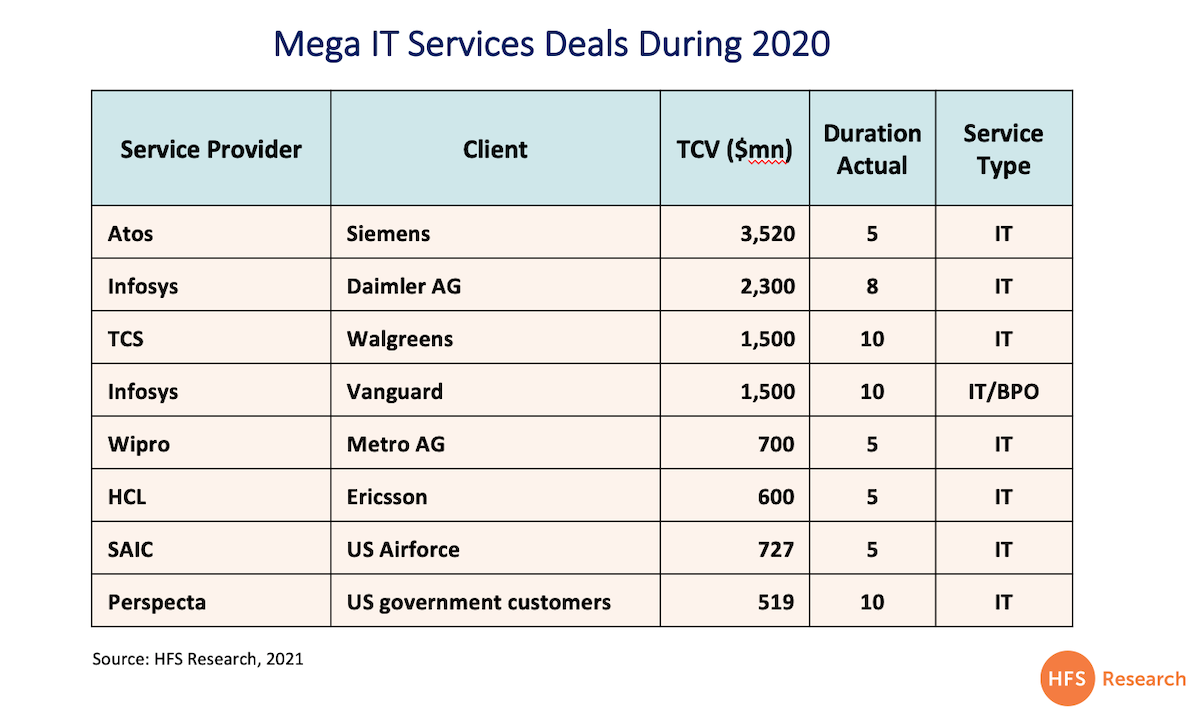
Against this background, the announcements that Atos and DXC are publicly reporting a potential takeover of DXC by Atos – in the region of $10 billion – are very surprising, as both firms have been struggling to keep pace with the market leaders for years, and Covid has not provided any respite for either, although DXC has shown some signs of arresting its decline under the leadership of Mike Salvino now in his second year at the helm. Having providers officially confirming takeover discussions is highly unusual, which indicates a merger could well be inevitable if the numbers add up to the stakeholders that matter. Yet, the central strategic question is whether there is an opportunity to consolidate and scale lower margin legacy businesses rather than focusing on investing in innovation.
Rather than getting bigger, these services firms need to spin off their legacy businesses. This proposed merger is illogical.
Currently, HFS sees little value in merging these two firms together, as the only potential value is more in scale and geography, as opposed to deep areas of innovation where both firms are struggling in this tough market. The muted reactions from Wall St tell enough of a story already – this whole merger proposal smells like a consolidation exercise that could be even less effective than the carnage caused when HP and CSC merged to form DXC in 2016. What’s more, Atos has struggled to derive much value from its major offshore-centric investment Syntel, so the chances of an Atos-led juggernaut of mainly legacy services business-lines being effective are highly questionable.
While we laud the value of OneOffice at HFS, this could be the antithesis version, with a hundred-plus ‘offices’ all grimly clinging to survival. We believe the IBM model of spinning out legacy business lines from growth business lines is the smart way forward. That is not to say a merged DXC and Atos could not pursue a smart strategy, but the simple fact that neither has done this to date gives us little confidence that they will.
So let’s take a look under the covers…
Atos and DXC are caught between a rock and a hard place: Losing out on recent large deals while having limited levers for margin improvement
The recent major contract wins of TCS at Walgreens, Infosys’ double swoop at Vanguard and Daimler, and Wipro at Metro paints a bleak picture. It is too simplistic to point out that some of these were asset-heavy deals as an explanation for the lack of success. In particular, in the context of Daimler, there is a strong cloud element and the synergies across the automotive ecosystem are immense in areas like supply chain, cloud agility and creating of data value. While in the Walgreens extension contract, a strong emphasis was placed on digital innovation. The key question for both providers is where revenue growth should come from as the anemic growth as Exhibit 1 highlights:
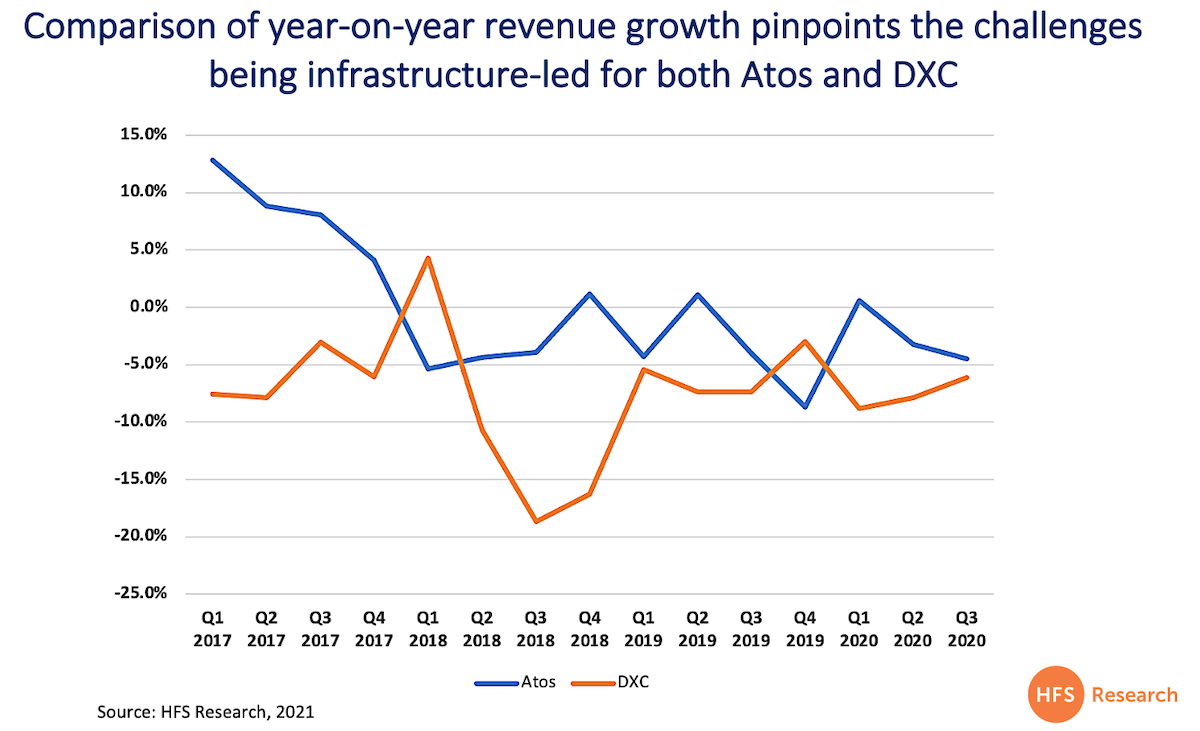
Click to Enlarge
If topline growth is not the priority then margins have to be improved by either extreme efficiency of operations and/or deep investments in innovation. As our Triple Trifecta Services Top 10 has demonstrated, neither organization made it to the overall Top 10. Atos has strong investments in innovation and a solid vision but struggles around execution. DXC has not even made the Top 10 in any of the various categories. As such deeper investments in innovation but more importantly, the execution of it should be top of mind to Atos.
The deal logic appears to hinge on three pillars:
- Finally, Giving Atos scale in the US market
- Cross-selling between accounts
- Aggressive cost take-out
Atos has a solid track record in M&A. While Syntel might have been fluffed, it managed to extract value out of stagnated businesses like Siemens, Xerox, and Bull. But we see the deal at best as a defensive move that would be buying Atos management time for other strategic moves. While Mike Salvino has stabilized DXC, he has taken over an organization that was demoralized and exhausted after continuous excessive cost-cutting and management change. . His task ahead is perhaps best illustrated by a comparison of operating margins. In Q3 2020, DXC was at 6.2% while Infosys achieved top-in-class with 25.4% and bellwether Accenture came in at 14.3%. Thus, the reported price of $10billion would represent a significant premium on a market capitalization of ca. $7.4bn that is likely to tempt shareholders to accept the offer.
Atos needs to reinvigorate around innovation – not legacy
M&A is in Atos’ DNA. The company is built on perpetual acquisition activity. The extension of the Siemens outsourcing contract in September 2020 is testimony that it can extract value even from highly challenging acquisition targets. Yet, DXC both in terms of scale as well as the culture would be its biggest challenge to date. The acquisition would also come at a time where the company is going through an organizational restructuring dubbed SPRING. With that Atos is moving from a largely horizontal go-to-market to one that is focused on verticals. OneCloud will be the first practice for this new organizational setup. Atos is late with a move toward verticalization and DXC is more advanced. But the key strategic issue goes beyond culture and integration. With the deal, Atos would become a consolidator of legacy businesses. Yet as Accenture and the Indian heritage provider demonstrate, value stems from moving aggressively toward innovation.
DXC is still suffering from its own ill-timed M&A
With a certain irony, DXC is still suffering from its ill-timed acquisition of EDS in 2008 at a time when the outsourcing market was shifting toward more discrete deals with a strong digital flavor. The margin erosion in ITO and infrastructure projects is still haunting DXC. However, in sharp contrast for instance to IBM, there is no RedHat in sight which could act as a catalyst for change. Rather Mike Salvino has evaluated “Strategic Alternatives” for three business units: the U.S., state, and local health and human services business; its horizontal BPS business; and its workplace and mobility business. The public sector business has meanwhile being sold while the other two units will be retained. But this process makes clear that the whole business model is under constant review. Despite more targeted moves like for Luxoft, it appears unlikely that DXC could turn into a consolidator. Therefore, its strategic options are limited.
Bottom-line: The consolidation of legacy businesses will make bankers and executive management happy, but it won’t transform Atos
While Atos might finally get to get to scale in the US, the proposed deal lacks imagination as neither firm adds much of the new world to the traditional world. The offshore component of both firms is not compelling when compared to any of the leaders. For example, their capabilities across the emerging market areas of the OneOffice platform, such as ServiceNow, Salesforce, Pega, SAP S4 Hana and Workday are not leading edge, and business process services investments across both firms have long been neglected. Yes, Atos management might be buying time for a more incisive transformation, but the strategic headwinds are already immense. Clients are looking for trusted partners to accelerate the Phase 2 services journey toward the OneOffice. Doubling-down on legacy-at-scale is hardly a compelling pitch to move up the value chain.
Posted in : Business Process Outsourcing (BPO), Cloud Computing, IT Outsourcing / IT Services, OneOffice

Joel Martin heads for the Cloud with HFS to lead the Cloud strategies practice
It’s funny when you meet these people across all corners of the globe during your career and you get that feeling that you’ll cross paths again in the future.
I first met Joel in 2002 when I was a Bio-IT analyst (yeah, I actually did that) in Australia working for IDC and Joel was running the PC tracker for the ANZ region.
Fast forward 19 years and Joel, and after his 10-year IDC stint, a couple of cyber-security and research startups; and a product marketing stint at Microsoft, got in touch about something that had nothing to do with the role for leading our new Cloud Practice was being advertised… I even asked him if he knew anyone when I thought “Hang on Joel, what are you doing these says…”.
To cut a long story short, Joel is now our first permanent Canadian employee, based in tropical Ottowa, with 2 daughters, (tries to) play guitar, and has mastered Bar B Qing at -20C. He has lived and worked all over the world and somehow still ended up in Ottowa. But that’s OK because we now officially have HFS Canada! He is also leading HFS’ new Cloud Practice to help the big pivot into the virtual work-anywhere world.
Phil Fersht, HFS: Before we get to all the work stuff, Joel, can you share a little bit about yourself….your background, what gets you up in the morning?
Joel Martin, Vice President Cloud Strategies, HFS: Great question Phil, thanks for asking.
About me, well, I like to think that I am a classic overachiever. I have built a career from a humble beginning to one that has allowed me to live, work, and experience cultures and peers in Europe, Asia, Australia, and North America. I love immersing myself in a new culture, have been fortunate to lead operations, sales, and research teams across the world, and thoroughly enjoy the customers I have engaged in finding new revenue opportunities.
I grew up in a small town in the United States, proud son of a Red Cross executive. As such, I got involved in community service from an early age, which continues to be important to me. Travel is something that I also grew up with, as early in my life, we lived in Germany and then across the U.S.
While at university, I built a partnership between the University in Leipzig and Houston, leading to my joining an international student-led program based out of New York City. This allowed me to travel extensively in Eastern Europe in the early and mid-90s, and honestly, I haven’t looked back. I started my technology career in Prague, Czech Republic, with IDC in 1997 and moved to Australia in 1999 and Toronto in 2004. Building a career in research, consulting, and practice leadership. Then I moved to Microsoft, where I was product marketing lead for the ERP business for Canada. In fact, I was part of the initial plans to move that product to the Cloud. After that, I was recruited by TechInsights, an Ottawa based Intellectual Property firm, to lead global marketing and product management. During this stint, I was part of the executive team that sold the business to a Private Equity firm and was retained to build exit strategies for different business lines.
During this time, both the company and the business I led went through significant digital transformation, taking our products and systems to the Cloud. This was a major undertaking as we fundamentally changed our financial, operations, HR, and customer-facing tools and experiences. That was 2015-2016, hard to believe nearly 5 years have passed.
Over the most recent 3 years, I ran workshops, managed client engagements, and wrote blueprints on building better supply chain relationships. I also supported a new program that focused on the impact of emotional connections between users that the software tools they use. Our hypothesis was that it is essential to look beyond the capabilities and features and understand what emotions drive satisfaction—a crucial component for marketing, sales, and buyer synergies.
Now I am excited to join HfS! As you and I worked together in the early 2000s in Sydney, while our paths diverged, we’ve found ourselves working together again.
As for what gets me up in the morning, I am an early riser, so after that first coffee cup, I like to explore problems with a fresh perspective. You know, before the in-box and to-do list from your boss dulls your creativity.
You’ve had a very global analyst career spanning several countries and continents… can you share some of your experiences over the years… what would you do all over again, and what would you definitely avoid?
When I look back at the crazy times of hitchhiking between meetings in Eastern Europe in the 90s to negotiating with a crooked cabbie in the middle of the night on a highway in China about the fare, there are undoubtedly many memories. And many things I would AND WOULD NOT do again!
The most important thing I always found while working abroad was being willing to listen. Not just to the customer or executive in the meeting, but to the colleagues, cabbies, and folks you meet while spending time in their country. Understanding another’s views based on their experiences, society, and culture has allowed me to apply my experiences in ways that have built more successful outcomes. In my experience, we often rush into conversations with our opinions and should take more time to listen.
So I do my best to avoid talking until asked. Instead, encourage the sharing of experiences, challenges, and opportunities. By making this investment, together, we can then build a prosperous relationship. Without doing so, it can be hard to establish the trust needed to collaborate equally and fruitfully.
How did you end up back in research after spending time with Microsoft?
My career’s second decade was on the supply side of the market. At Microsoft and TechInsights, I succeeded in developing products, managed partner programs, and delivering on go-to-market strategies. Something I’d advised on in my first decade at IDC, but with little real experience.
So, after developing skills as a business leader responsible for multi-million dollar P&Ls and a global workforce and taking some time off after leading the efforts to sell a line of business, research just came naturally to me. I found myself interested in a more holistic view of strategy, from product design and development to competitive go-to-market to contracting and negotiations.
Contracts, I have found, are often overlooked by business and tech leaders. While they can be boring, having read 1,000s of them, I have a good sense of what to look for in terms of fairness and remediation. Understanding the legal aspect of the relationship must be a big part of any cloud strategy. Technology and business leaders should be investing time to study the impact their supplier agreements may have on success!
You’ve chosen to focus heavily on the Cloud at HFS… can you share your passion here? What are your goals?
Technology has been seen as a game-changer to business models and service delivery for the past 2 decades. In fact, being a fan of Star Trek continue to be amazed at how much of today’s technologies were dreamed up by the series in the 60s. However, one thing Star Trek missed was the importance and power of the Network.
It is the Network, not called the Cloud, that is changing the game. This goes beyond computing power and ease of delivery/access; it means this nearly ubiquitous platform can power the workforce and business process needs of organizations, governments, and supply chains. At HFS, I’ll be working to link the One Office, Triple-A-Trifecta, and native automation efforts into a context that both the technology leader and business leader can execute upon.
Exciting stuff! And very meaningful as we toss “digital transformation” out the window and focus on a real evolution of the business, powered by process excellence and underpinned with Cloud technologies.
What role do you see analysts playing as we emerge from this pandemic? Same old game, or is something new brewing?
Obviously, my perspective is biased based on my experiences and how I have been successful. I believe companies will benefit the most from analysts with backgrounds as business leaders themselves. I also believe the Cloud is fundamentally a state-less technology; as such, possessing global experience is essential to adding context to those selling, buying, deploying, and supporting these strategies.
I like to think of myself less as an analyst and more as a part of a strategic team of advisors. Articulating the “what next” in terms of workforce, process, and technology is what an executive should value over just getting another opinion about how they address today’s problems in isolation.
This is what attracted me to HFS. I look at my peers and their experiences across industries, professional backgrounds, and geographic locations. We are well-positioned to offer wisdom over just intelligence. And this is what I feel an organization should be seeking these days when it seeks to augment its data and insights with an outside 3rd party.
What do you think we’ll be talking about when we gradually revert to a world beyond our screens? Will we get a resurgence of energy and excitement, or will we crawl out of our caves blinded by the sunlight?
The fundamental change is that the business knows that the Cloud is no longer a digital service delivery tool. Instead, it is essential to service, workflow, employee and customer experience, and success. Customers and employees are intertwined in a cloud-based supply chain. They do not need in-person experiences as often, nor will they seek them out. Gone are trips to solve tactical problems, glad-hand a business opportunity, or pitch an early-stage project.
Our screens are part of the business now. When travel returns, it will be for strategic reasons, such as fostering trusted relationships, motivating our teams, and gaining experiences by listening, not selling, to the other person.
Well, it’s great having you onboard Joel – looking forward to some intense research in 2021!
Posted in : Cloud Computing, IT Outsourcing / IT Services, Outsourcing Heros
